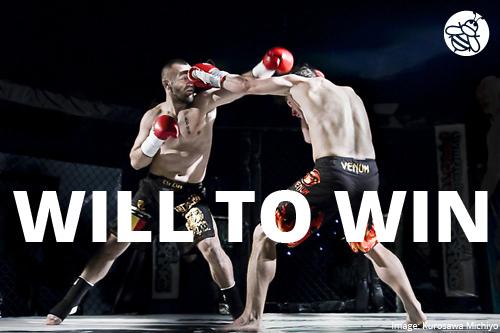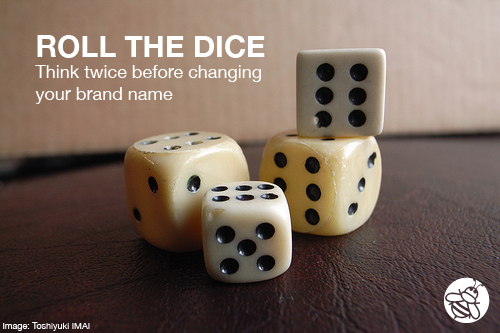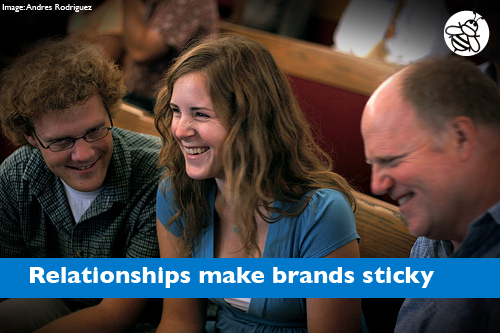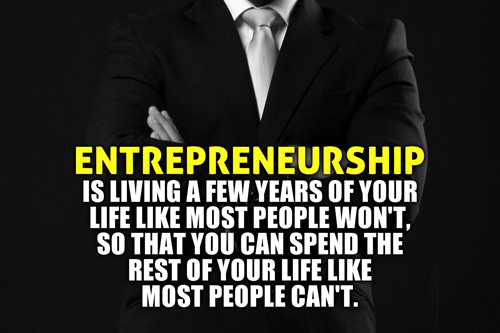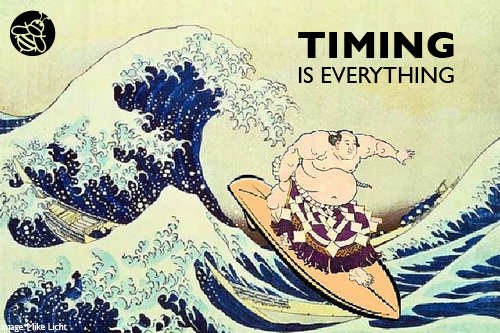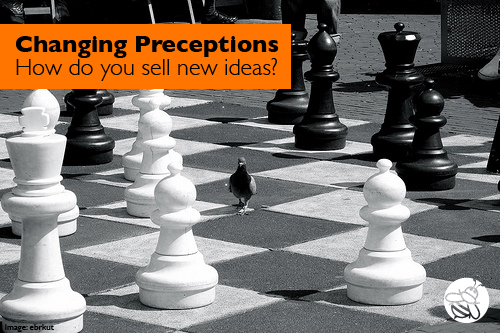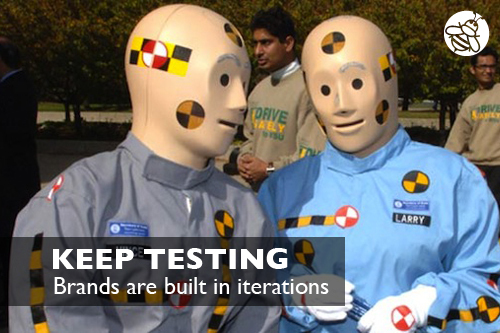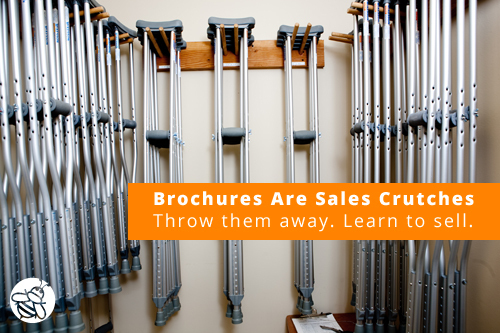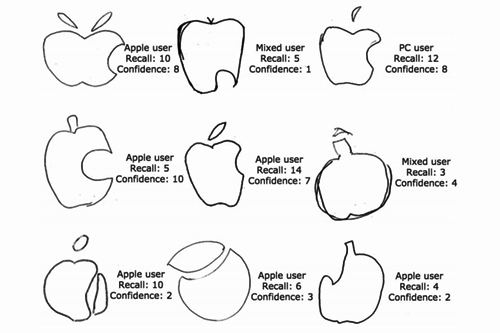Jeremy Miller's Blog, page 38
April 16, 2015
The Will To Win
How badly do you want your brand to win?
Does your team have the will to fight?
Do they take every challenge personally?
Brands that win, fight. Growing a Sticky Brand takes more than building a strategy and executing it. It’s personal. It’s you versus them. And losing is not an option.
Dave Logan (et al.) writes in Tribal Leadership, “Most strategies are based on an understanding of the external environment, not the highest aspirations of the tribe. As a result, even the best plans often fail because people aren’t giving it their all.”
It’s the will to win that separates average companies from Sticky Brands. Any team can come up with a brilliant idea, but only the driven will see it through to the finish line.
Every Superhero has an Arch Enemy
Who is your team fighting against?
Marc Benioff, CEO of Salesforce.com, writes in Behind the Cloud, “Salesforce.com only acknowledged one competitor — the market leader. After all, that was the only position for which we were vying. Furthermore, it cast us in the right role as the underdog and visionary. It’s always wise to play the visionary card. Everyone roots for you. If there is no Goliath in your industry, go after the status quo.”
A hero has an arch enemy. It’s that big scary monster that you have to defeat.
In the early years, Salesforce.com built its brand by challenging (and ultimately defeating) Siebel. Apple built its brand by challenging Microsoft. Starbucks built its brand by challenging the status quo of cheap, diner coffee.
What is your brand’s arch enemy? Identify the enemy to your brand:
The market leader
The status quo
Someone else
David Versus Goliath
Defeating an arch enemy is no easy task.
When Salesforce.com attacked Siebel in 2001 they were a tiny startup with a few million in revenue. Siebel in contrast was a publicly traded company with revenue of $1.8 billion and 8,000 employees.
It was a classic David versus Goliath story. The small but very aggressive startup attacked the market leader until it became the Goliath of the CRM industry.
Siebel was acquired in 2006 by Oracle. It was hurt by the tech wreck of the early 2000’s, and it did not have an effective response to Salesforce.com’s software-as-a-service business model.
You’re not going to change the status quo overnight, and that means you need the stamina to attack again and again.
Each small victory is a step forward. Each attack is a progression. Every day your team has to reenergize itself to take on the fight and attack again.
Rally Your Team to Fight
A fight is personal. You’re defending your convictions. You’re protecting your customers. You’re challenging the status quo. You are defeating your brand’s arch enemy.
Fight!
A team that is driven to fight and challenge conventions will go far further than a team that’s executing a business strategy.
A team that takes every challenge personally will push harder and accomplish more faster than a team of “doers.”
A team that wants to win and is committed to winning will grow a Sticky Brand.
April 14, 2015
Think Twice Before Changing Your Brand Name
Changing your brand name is an expensive proposition. It’s definitely not a decision to make lightly.
In 2004 I lead the rebranding of my family’s business. We did a complete rebrand:
New name: Changed the company name from Miller & Associates to LEAPJob.
New positioning: Repositioned the business from IT Staffing to Sales & Marketing Recruiting.
New identity: New logo, tagline, and imagery.
The new brand was brilliant, especially when compared to where we came from. But the transition was costly. It was like hitting the reset button and becoming a startup all over again.
A Name Has History
Most aspects of your brand identity are relatively easy to change. Customers don’t think twice about a new logo, new website, or new marketing campaign.
But a name is packed with meaning.
Imagine what it would be like if you changed your first name. How would friends, colleagues, and family respond to the new name? How long would it would take for them to start referring to you by the new name?
A brand name, even a boring brand name, gains meaning over time. The more people interact with your company the more they get to know it. Those experiences build upon each other and become associated with the name.
For example, when someone asks, “Have you heard of [insert brand name]?” A common response will be “yes” followed by a story or example of what you know of the business. The name is the focal point of the brand experience.
When you change the brand name you risk losing all of those past memories and experiences.
When to Change a Brand Name
Changing a brand name is drastic and should be only used in very specific circumstances:
Mergers & Acquisitions: This is the most obvious reason for a name change. One plus one does not deserve a hyphenated name. A name change following a merger is a logical process with the integration (or absorption) of the firms.
Product Growth: There are several examples where the product brand outgrows the company brand. changed its company name to Basecamp. Basecamp was its flagship product and what the business became known for. changed its corporate name to Blackberry for the same reason.
Repositioning: In drastic cases, like what I did with my family business, a name change fits the repositioning strategy. The name change signals that the business has reset and is serving a new market.
Geographic Expansion: The other major reason for a name change is to serve different geographic markets. Not all names translate well across languages and cultures. You may choose to change your brand name in order to compete globally, or develop localized brands for each market you serve.
Transition the Name Slowly
If you make the bold choice to change your brand name, transition the name deliberately:
Over communicate internally and externally.
Clearly articulate the “why” behind the name change.
Maintain links, especially in Google, to the old name.
Transition the name slowly (9+ months).
A name change is different from a new logo or tagline, because it functions as a mental reference point. You’re going to need to educate your customers on the new name and help bring along as much of the history as possible to the new name.
April 9, 2015
Come For The Service, Stay For The Relationship
The simplest things can make your brand sticky.
I am continually surprised by the power of relationships. This hit home for me this week as I returned to Element Crossfit after a nine month hiatus.
I was lured away by the enormous Lifetime Fitness near my home. On paper Lifetime has everything: 3 pools, saunas, a spa, rock climbing walls, every fitness class imaginable, tons of free weights, and hundreds of cardio machines. And all of this is laid out in a stunning 150,000 square foot facility.
But for all of Lifetime’s features it was lonely. It was like going to the mall. Lots of people, and no one knows each other.
Returning to Element was a stark contrast. Element Crossfit is minimalistic in comparison, but its community is incredible. Within minutes of walking into the gym I was greeted by old friends, introduced to new members, and immediately incorporated into the culture.
The people make the experience stick!
Relationships Create Comfort
Strong relationships form a bond with your clients. It makes your brand comfortable.
To illustrate this, do you have a favorite restaurant — one you visit on a regular basis? If so, what do you enjoy most about the restaurant?
For years I went to a local sushi restaurant, Kumai. My wife and I went every Friday for date night, and I’d stop in a couple times a week for lunch. The food was excellent, but it was the people that made the restaurant special. We knew the owner and his staff, and they knew us. And over the years we became friends. The relationships enriched the experience.
In 2013 Kumai-san retired and closed the restaurant, and I still miss it. It felt like home to go there.
Make Personal Connections a Priority
Forming deep, personal connections with your clients is not accidental. As an organization you either prioritize customer relationships or you don’t. There really isn’t a middle ground.
Element Crossfit takes its member relationships very seriously. As a small business they cannot compete with the features and benefits of large, publicly traded companies like Lifetime Fitness. But they can compete and win by focusing on the essence of their brand experience.
Community and relationship building are baked into the business’s core values.
Element’s staff are trained and managed on how to interact with the members. Events and activities are organized to facilitate members interacting with each other. And deliberate attention is made to grow a community.
Many of these activities are insanely easy to implement. For example, before each class the trainers do a short exercise with the members to foster connections. They’ll have each member introduce themself and answer a short question like, “How do you make your cereal? Do you pour the cereal in first or the milk?”
The question is innocuous, but it sparks a short conversation and sets the tone for the rest of the class.
These activities build upon each other, and very soon Element forms a deep bond with its customers. The gym becomes a very comfortable place.
Relationships Make Brands Sticky
It’s easy to overlook the impact personal connections can have on your brand. But relationships can tilt the odds in your brand’s favor.
Forming deep personal connections with your customers enriches the experience. It makes your brand more comfortable, but it also makes it more desirable.
Customers naturally gravitate towards the brands they know, like, and trust.
April 7, 2015
How To Use Metaphors In Branding
Metaphors are powerful communication devices in branding. They act as a lens to get people to consider ideas or concepts in new ways.
Phrases like Acid Rain, Permission Marketing, or Organic Foods are packed with meaning. The pairing of words creates a metaphor that shapes understanding and expectations. And this approach is equally effective in branding.
How do you describe your brand:
Your brand is [insert metaphor]
Your brand is like [insert simile]
The addition of a metaphor or a simile adds context to your brand. It creates a mental picture that helps to make your brand easier to understand, easier to talk about, and easier to share.
Place the Metaphor First
Where you place a metaphor influences its impact. A metaphor placed too late is basically useless.
Whole Foods, for example, leads with the phrase “natural and organic foods.” This is their lens. Everything they do positions off natural and organic, and this shapes our understanding of the brand and what they deliver.
The positioning of “natural and organic foods” is important. If Whole Foods were to say, “We are a grocery store with over 365 locations globally. We sell over 3,300 products, and they are all natural and organic.” The impact of the metaphor is lost.
Metaphors are only persuasive in branding when you lead with them. If you place the metaphor at the middle or end of your argument they have little to no impact.
Repetition Creates Comfort
Using your metaphor once isn’t enough either. Repeat it over and over again. The more you use it the more effective it will become.
A good way to understand the power of repetition is to consider your favorite song. How many times have you listened to the song? Probably hundreds or thousands of times. This repetition is powerful. You know the lyrics and the tune, but more importantly the song is intrinsically linked with moments in your life. The song has been with you repeatedly, and that’s part of what makes it so appealing and comfortable for you.
The same is true for your brand. The more you use the metaphor, the more it will be associated with your brand.
If we return to our Whole Foods example. They use the words “natural” and “organic” everywhere. Whole Foods leads with the phrases and repeats them consistently, and that repetition creates comfort and trust. We know where the brand fits in the marketplace and what it delivers.
Own the Metaphor
Your metaphor can become integral to your brand positioning. “Your brand is …”
Fill in the blank. What metaphor best describes your brand? What phrase or description do you want your customers to associate with your brand?
Take this brand and own it. Lead with it and repeat it over and over again.
April 2, 2015
Entrepreneurship: It’s The Life We Choose
“Entrepreneurship is living a few years of your life like most people won’t so you can spend the rest of your life like most people can’t.”
I don’t know who said this quote, but it’s stuck with me for several years. There’s so much truth to it.
At first you might think it’s about the money — I know that’s why I originally saved the image above. But that’s not it. Most entrepreneurs make less than their peers working in salaried jobs. There are a few entrepreneurs that make it big, but they’re not the average.
Money is not what sustains entrepreneurs to do what they do. Being an entrepreneur is a lifestyle and it’s ultimate reward is freedom:
Freedom to build
Freedom to develop people and teams
Freedom to innovate
Freedom to cut your own path
It’s not an easy lifestyle, but it’s a rewarding one.
Compelled To Create
I’m getting home from a whirlwind of travel over the past 3 weeks. I was developing brand strategies with clients in Norway, Canada, and the United States.
I was reflecting on my travels as I flew home last night, and I was struck by how entrepreneurs share a bond. We are compelled to create.
It doesn’t matter where you’re from or what language you speak, if you’re an entrepreneur you have this deeply ingrained feeling. It’s hard to put to words, but it’s there.
Entrepreneurs create businesses, products, and brands that didn’t exist before them. They bring together talented, like-minded people. They build teams. They invest and innovate to realize their dreams. And they work and toil, often for years at a time, to make their vision a reality.
Entrepreneurs have an internal spark and tenacity that really drives them to create.
The Lifestyle Isn’t For Everyone
I often describe the life of an entrepreneur as manic: massive highs followed by crashing lows.
Ask any entrepreneur, and they’ll agree. It’s the life we choose. Building a business and a brand is a journey fraught with obstacles and challenges, but to overcome them is a delight.
Building an idea — whether it’s a business, product, brand, or a community — is a long hard journey. We don’t have a crystal ball, and inevitably we fall down and fail over and over again. But this is all part of the process. As we try and fail, we learn and grow. And this forms the foundation to build a business.
Not everyone is cut out for this journey. There have been many days where I have dreamt of a nice salaried job with benefits — oh how glorious that must be. But I can’t imagine doing anything else.
The compulsion to create is too powerful to give up. And seeing this struggle in other entrepreneurs reinforces this is why we do what we do.
Money Is a Result
The success many people witness with entrepreneurs is years in the making. Many entrepreneurs will say, “I am a 20 year overnight success.”
Entrepreneurs are compelled to build, and are then celebrated for their accomplishments. But the journey is as important for the entrepreneur as the results.
Being an entrepreneur affords you a lifestyle that many people will never experience. You get to do things and create things that would just not be possible any other way.
March 31, 2015
Timing Is Everything: Dust Off Old Strategies
“We tried that before. It didn’t work.”
This is a common statement. People try ideas, but for a variety of reasons they don’t work out.
I heard this all the time when I sold CRM systems a decade ago. Prospects would call in to discuss their software needs. They saw the potential, but could not make a purchase decision. They faced insurmountable internal hurdles because of a prior failure. The appetite to try the project again was not there.
But a prior failure doesn’t mean the idea lacks merit.
Timing is everything. Don’t let a prior failure hold you back from dusting off and trying the strategy again.
Great Ideas Have a Moment in Time
Steve Jobs had a knack for getting the timing right. When the iPod launched in 2001 it became in instantaneous success. Apple sold over 220 million units in eight years.
But Apple wasn’t the first to conceive of a digital music player. Sony had two fully functional players two years before Apple, but the timing was wrong. The technology was immature, and consumers were not ready for it yet.
If Apple had judged the potential of the digital music market based on Sony’s failure the iPod, iPhone, and even the iPad would never have happened.
Timing is a crucial component of strategy. An idea launched too early will fizzle. It might capture people’s attention, but fail to make an impact.
Do You Have the Infrastructure to Succeed?
Often prior failures were caused by a lack of infrastructure. The strategy had merit, but the conditions for success were lacking.
A marketing plan that failed previously could have been dragged down by an immature product, weak execution, the wrong partners, or a multitude of conditions.
But that doesn’t mean you shouldn’t try the plan again.
As your business grows and evolves the conditions for success change too. Dust off the old strategies and reconsider them. What could you do with these strategies today with the skills, expertise, and resources you possess?
Start With An Open Mind
A failure, especially a visible one, can be very painful. It leaves a scar, which can hold you back.
When someone proposes an idea that you’ve tried and failed at previously, don’t reject it outright. Reconsider it. Take a moment to re-examine the plan within your current business conditions.
Could you tweak your approach? What would you do differently this time?
Sometimes it’s just a matter of timing. Are the conditions there for you to be successful with the old strategy at a new time?
March 26, 2015
3 Strategies to Sell New Ideas
Bringing a new idea to market can be extremely frustrating. You see the potential. You see how your solutions will solve problems and aid customers, but they don’t act.
Buying is habitual. Customers buy what they know, like, and trust. It can take monumental forces to overcome this resistance and motivate your customers to change their buying behaviors.
But there are proven techniques and strategies to overcome resistance to a new concept. In this post I will share three strategic frameworks you can use as a starting point to build your strategy to sell a new idea into your marketplace.
1. The D-Day Strategy
Often the biggest point of resistance to a new idea is proof. Customers want to see it working before they will implement it.
The D-Day strategy is a niche marketing approach popularized by Geoffrey Moore in his book Crossing the Chasm. The idea is to create credibility in a niche market, and then use that grouping of customers to attack other customer segments.
Moore compares the strategy to D-Day, the Allied Forces attack on Normandy in World War II, because of the sheer focus on winning the niche. Normandy was a crucial victory for the Allies, because it created a foothold in Europe and changed the tide of the war.
The D-Day strategy has two critical components. First, it’s an “all in” strategy to win a niche market. Every resource is applied to win a clearly defined group of customers (a horizontal or a vertical) with relevant traits and needs.
The second component is identifying where the niche leads to. The niche is simply a foothold to attack larger, more strategic markets. Taking France gave the Allies access to Europe. Where does your niche market lead to? Drive through the niche to the next logical group of customers.
Each niche provides credibility and customer testimonials to expand your new idea into the general marketplace.
2. The Trojan Horse Strategy
Sometimes the resistance and barriers to entry to a new idea can be so great that the D-Day strategy is ineffective.
So again, we look to war strategy for inspiration. The “Trojan Horse” is a tale of how the Greeks took the city of Troy, which had been under siege for ten years. The Greeks tried and tried for a decade to take the city, but could not break through the walls.
The Greeks’ strategy is one of deception. They deployed the wooden horse as a gift, and appeared to sail away in defeat.
In celebration the Trojans pulled the horse into their city as a victory trophy. However, that night the Greek contingent hidden inside the horse crept out and opened the city’s gates. The rest of the Greek army — the ones who pretended to sail away — were waiting and the city of Troy was destroyed.
In a marketing context, the Trojan Horse strategy focuses on bundling your new idea within existing services. If you can’t get the customer to adopt the new idea, can you get them to absorb it into their company elsewhere?
The Trojan Horse strategy works well in established firms that are launching new products and services. They bundle the new offering with core services, and then look for ways to expand upon the new idea once it’s inside the customer’s organization.
3. A Rising Tide Strategy
The third approach is potentially the most complicated, but also the most powerful. Instead of competing directly — displacing one choice for another — build the category. Rise the tide for your entire industry.
Whole Foods, for example, created a new category in grocery stores: organic foods. It took organics from a fringe market to the mainstream. They didn’t focus on competing in a niche and beating other like minded organic grocery stores, they built a category. They marketed organics, popularized the category, and raised the tide for everyone.
As a result, Whole Foods elevated an entire industry and became perceived as the leader of that market. And in light of the company’s success, other mainstream grocery stores had to follow suit to provide organic and natural products.
A Rising Tide strategy is highly effective, because you market the big picture. But it’s also a longterm strategy. It’s often wise to blend this strategy with the D-Day or Trojan Horse approach to shore up your sales in the short term.
Adapt the Strategy for the Idea
The three strategies are starting points. Build upon them. Adapt them. Make them your own.
Every strategy requires context:
What does it take to get your customers to change their behaviors?
What does it take to get people to consider the new idea?
What does it take to get your customers to refer and share the great work they are achieving with your idea?
March 24, 2015
Brands Are Built In Iterations
It’s very rare to find a brilliantly simple solution on the first try. Eureka moments come far further down the cycle.
Trial, discovery, and iterations are an essential ingredient in finding brilliant ideas.
A Brand Is Built In Steps
Iconic brands are built over decades and thousands of iterations.
Starbucks is one of the most successful and profitable quick serve restaurants in the world. Over the course of 30+ years the company has grown an iconic brand. The brand is well managed and understood, but it took a great deal of iteration and experimentation to get the brand to what it is today.
For example, Scott Bedbury writes in A New Brand World, “I knew the aliens were among us when, in the course of a retail business review session, it was suggested that Starbucks remove the small ‘short’ cups and introduce a whale of a beverage container that would be more profitable. The largest size Starbucks had at the time, sixteen ounces, was a grande. What would we call the larger size? Mucho grande?”
We call these larger cups venti today, and most people think nothing of it. It’s just part of the Starbucks brand. But as you can see from Scott’s description, the venti cup was a contentious topic.
This is not unusual to Starbucks. All brands go through iterations. The ideas that work are kept, built upon, and developed. The ones that don’t work are learning opportunities.
Build Trial and Discovery Into Branding
Great ideas take work. Give yourself and your team the room to play and learn.
In my approach to brand building, I am constantly looking for opportunities to convert ideas into action. I’d rather try an idea in a contained environment than continue to brainstorm and debate at the boardroom table.
The faster you can get in front of customers, the faster you can validate an idea.
This learning is invaluable. Not only do you discover if your idea has merit, you build upon it. You give it context. You shape and mold it. You give the idea room to grow into something that can actually shape your brand.
Create Feedback Loops To Learn Faster
With each iteration create feedback loops. An experiment without measures isn’t very useful.
Identify the data points or insights you want to capture at each iteration. What do you want to learn? What do you want to prove? What do you want to know?
The feedback loops don’t have to be complicated. One of my favorite tools to test brand messaging (Simple Clarity) is the Win/Loss Card™. This is a qualitative assessment a salesperson completes after they deliver a pitch to a prospect, client, or referral partner. The process is inexpensive, easy to implement, and can deliver insights in less than two weeks.
There are lots of ways to gather insights. Choose the tools and process that fit the goals of each iteration.
Iterate Quickly
Ideation requires action. As you discover ideas, test them. Implement them and gather insights.
The faster you can iterate, the faster you can grow a Sticky Brand.
March 19, 2015
Brochures Are Sales Crutches
Do you have a supply closet full of brochures and marketing collateral in your office? If so, I have a challenge for you: throw them away.
Brochures and sales sheets don’t help the sales process. They don’t make it easier for your customers to buy. They don’t solve problems.
Brochures are sales crutches. They prop up weak salespeople and indistinguishable brands.
Brochures Delay “No”
Every warning bell should be ringing if you hear a customer say, “Send me your literature.”
Some salespeople misinterpret these requests for information as signals that the customer is interested and ready to buy. The reality is much different. “Send me more information” is a nice way of saying, “Thanks, but no thanks.”
Nobody likes to say no. It’s uncomfortable. It feels rude to tell an eager salesperson you’re not interested in them or their services. So customers look to softer ways to deflect the sales process.
Asking for a brochure is a soft commitment that doesn’t really mean anything.
Make Salespeople Sell
A salesperson’s job is not to convince and cajole a customer into buying. Their job is to find and solve a problem — acquiring the customer is the result of that process.
The brochure is a distraction. Make the salesperson actually do their job:
Prospect and discover opportunities
Qualify fit and interest
Demonstrate capabilities and prove the value of your services
Negotiate and close
An attractive marketing kit may be a nice leave behind, but it doesn’t create value. It doesn’t answer questions. It doesn’t discover needs. It doesn’t demonstrate capabilities.
Brochures Slow Down Sales
If for no other reason, get rid of brochures because they slow down sales.
Every time a salesperson sends out a brochure they slow down the sales process. First it takes a few days for the marketing kit to arrive at the customer’s office. Then the sales rep follows up with a call a week later to see if the package arrived. Best case scenario the salesperson gets the customer on the phone and they schedule next steps. But the more likely scenario is the call hits voicemail and phone tag begins.
Meanwhile, the competitor that didn’t use a brochure has already qualified the prospect.
The competitor knows if there is a real opportunity, and is scheduling presentations or delivering quotes. They achieve a significant advantage in the sales process.
The simple act of sending a brochure can cost you a sale.
Throw Away the Brochures
There aren’t many scenarios I can see where salespeople need brochures. Send the customer to your website if they want more information. Or better yet, sell. Figure out what the customer needs and work to solve the problem.
You don’t need a glossy marketing kit to solve customer problems or differentiate your brand.
March 17, 2015
Most People Can’t Draw the Apple Logo
There’s a misconception in marketing. A brand is grown on the work you do, not the words and images you use.
This was demonstrated by a recent study by psychologists at UCLA. They asked people to draw the Apple logo from memory — surprisingly few people could do it.
The Apple logo is one of the most iconic brand symbols. Walk into any Starbucks and you will see the logo on device after device. The logo is on billboards, it’s in stores, it’s online — the Apple logo is everywhere.
According to the study, “Only 1 participant out of 85 correctly recalled the Apple logo, and fewer than half of all participants correctly identified the logo.”
Test yourself. See how you fair.
Customers Don’t Care About Marketing
As marketers and business people we can be captivated by Apple’s marketing, but its brand identity is not the source of Apple’s success.
As Tom Asacker writes, “The reach and frequency of the Apple logo is over the top. So why can’t most people recall and draw the correct one? I’ll tell you why. It’s irrelevant to most people. The details of the Apple logo simply don’t matter. The same is true of most marketing. The images, sounds and words don’t really matter all that much to most people. And so they’re not stored in long-term memory.”
And that’s the sum of it. People buy products and services, and they buy results and experiences. They don’t buy logos, taglines, websites, and marketing.
Marketing Is a Weapon
Apple stands out as one of the most successful brands and companies in history, because it plays to win.
Apple wasn’t the first in the music business. It wasn’t the first in the smartphone business. It wasn’t the first in the tablet business. And it’s not the first in the smartwatch business. But every time Apple enters a market, it enters to win.
The brand identity is just one arrow in Apple’s quiver to fend off direct competitors, and give it license (and credibility) to enter new markets.
The same is true for your brand identity. The images and words are tools that serve the business strategy:
What resources do you need to attract customers?
What does your company have to do to fend off the competition and create competitive immunity?
What’s your strategy to win?
Marketing Serves the Business
Geoffrey Moore writes, “marketing is warfare — not wordfare.”
I love it. This is one of my favorite quotes, because it gets to the heart of the matter. Logos, taglines, websites, and marketing campaigns serve the business — not the other way around.
A brand is the sum of its parts. The visual identity is just the wrapping paper to make it a wee bit more appealing.

